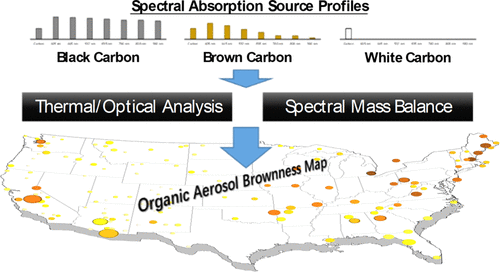当前位置:
X-MOL 学术
›
Environ. Sci. Technol.
›
论文详情
Our official English website, www.x-mol.net, welcomes your feedback! (Note: you will need to create a separate account there.)
Brownness of Organic Aerosol over the United States: Evidence for Seasonal Biomass Burning and Photobleaching Effects
Environmental Science & Technology ( IF 11.4 ) Pub Date : 2021-06-15 , DOI: 10.1021/acs.est.0c08706 Lung-Wen Antony Chen 1, 2 , Judith C Chow 2, 3 , Xiaoliang Wang 2 , Junji Cao 3 , Jingqiu Mao 4 , John G Watson 2, 3
Environmental Science & Technology ( IF 11.4 ) Pub Date : 2021-06-15 , DOI: 10.1021/acs.est.0c08706 Lung-Wen Antony Chen 1, 2 , Judith C Chow 2, 3 , Xiaoliang Wang 2 , Junji Cao 3 , Jingqiu Mao 4 , John G Watson 2, 3
Affiliation

|
Light-absorptivity of organic aerosol may play an important role in visibility and climate forcing, but it has not been assessed as extensively as black carbon (BC) aerosol. Based on multiwavelength thermal/optical analysis and spectral mass balance, this study quantifies BC for the U.S. Interagency Monitoring of Protected Visual Environments (IMPROVE) network while developing a brownness index (γBr) for non-BC organic carbon (OC*) to illustrate the spatiotemporal trends of light-absorbing brown carbon (BrC) content. OC* light absorption efficiencies range from 0 to 3.1 m2 gC–1 at 405 nm, corresponding to the lowest and highest BrC content of 0 and 100%, respectively. BC, OC*, and γBr explain >97% of the variability of measured spectral light absorption (405–980 nm) across 158 IMPROVE sites. Network-average OC* light absorptions at 405 nm are 50 and 28% those for BC over rural and urban areas, respectively. Larger organic fractions of light absorption occur in winter, partially due to higher organic brownness. Winter γBr exhibits a dramatic regional/urban–rural contrast consistent with anthropogenic BrC emissions from residential wood combustion. The spatial differences diminish to uniformly low γBr in summer, suggesting effective BrC photobleaching over the midlatitudes. An empirical relationship between BC, ambient temperature, and γBr is established, which can facilitate the incorporation of organic aerosol absorptivity into climate and visibility models that currently assume either zero or static organic light absorption efficiencies.
中文翻译:

美国上空有机气溶胶的褐色度:季节性生物质燃烧和光漂白效应的证据
有机气溶胶的光吸收率可能在能见度和气候强迫方面发挥重要作用,但尚未像黑碳 (BC) 气溶胶那样得到广泛评估。本研究基于多波长热/光学分析和光谱质量平衡,量化了美国受保护视觉环境机构间监测 (IMPROVE) 网络的 BC,同时开发了非 BC 有机碳 (OC*)的褐色指数 (γ Br ) 以说明吸光褐碳(BrC)含量的时空趋势。OC* 光吸收效率在 405 nm 处为 0 至 3.1 m 2 gC –1,分别对应于 0% 和 100% 的最低和最高 BrC 含量。BC、OC* 和 γ Br解释了 158 个 IMPROVE 站点测量的光谱光吸收(405-980 nm)的可变性的 > 97%。405 nm 处的网络平均 OC* 光吸收分别是农村和城市地区 BC 的 50% 和 28%。冬季光吸收的有机部分较大,部分是由于较高的有机褐色。冬季 γ Br表现出显着的区域/城乡对比,与住宅木材燃烧产生的人为 BrC 排放一致。夏季,空间差异减小到均匀低的 γ Br,表明中纬度地区存在有效的 BrC 光漂白。BC、环境温度和γ Br之间的经验关系 建立,这可以促进将有机气溶胶吸收率纳入目前假设零或静态有机光吸收效率的气候和能见度模型。
更新日期:2021-07-06
中文翻译:

美国上空有机气溶胶的褐色度:季节性生物质燃烧和光漂白效应的证据
有机气溶胶的光吸收率可能在能见度和气候强迫方面发挥重要作用,但尚未像黑碳 (BC) 气溶胶那样得到广泛评估。本研究基于多波长热/光学分析和光谱质量平衡,量化了美国受保护视觉环境机构间监测 (IMPROVE) 网络的 BC,同时开发了非 BC 有机碳 (OC*)的褐色指数 (γ Br ) 以说明吸光褐碳(BrC)含量的时空趋势。OC* 光吸收效率在 405 nm 处为 0 至 3.1 m 2 gC –1,分别对应于 0% 和 100% 的最低和最高 BrC 含量。BC、OC* 和 γ Br解释了 158 个 IMPROVE 站点测量的光谱光吸收(405-980 nm)的可变性的 > 97%。405 nm 处的网络平均 OC* 光吸收分别是农村和城市地区 BC 的 50% 和 28%。冬季光吸收的有机部分较大,部分是由于较高的有机褐色。冬季 γ Br表现出显着的区域/城乡对比,与住宅木材燃烧产生的人为 BrC 排放一致。夏季,空间差异减小到均匀低的 γ Br,表明中纬度地区存在有效的 BrC 光漂白。BC、环境温度和γ Br之间的经验关系 建立,这可以促进将有机气溶胶吸收率纳入目前假设零或静态有机光吸收效率的气候和能见度模型。



























 京公网安备 11010802027423号
京公网安备 11010802027423号